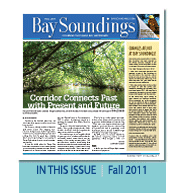 |
||||||||

Celebrating Tampa Bay Estuary Program
Observes Its 20th Anniversary
By Holly Greening, Executive Director Tampa Bay Estuary Program
Twenty years ago, Tampa Bay was designated an "Estuary of National Significance" by Congress, joining a small and exclusive group of the nation's most fabled – and troubled — waterways. Like its sister estuaries of New York Harbor, Puget Sound and San Francisco Bay, Tampa Bay had been pummeled by decades of
dredging, development and disregard.
At the time of its entry into the National Estuary Program, Tampa Bay already had a dedicated corps of scientists, planners, elected officials, industry leaders and passionate citizen-advocates who had been working cooperatively, across political and geographical boundaries.
Those early efforts already were beginning to reap dividends when the Estuary Program came along. A remarkable transformation was underway, thanks to substantial federal investments in wastewater system upgrades on both sides of the bay and a flurry of new federal and state legislation that limited dredging and industrial discharges, required treatment of stormwater runoff for the first time and imposed strict treatment standards on sewage piped to the bay.
Life-sustaining seagrasses were again growing in areas that had been bare for years. The water became clearer and less clouded with algae. Wading birds like roseate spoonbills — which had completely disappeared from Tampa Bay by the 1940s — were returning to nest on islands throughout Tampa Bay. The mighty tarpon, once the target of a famous fishing tournament in downtown Tampa that was halted in the 1970s when the "Silver Kings" vanished from the bay, began to reappear to test the skills of avid anglers.
The Tampa Bay Estuary Program did not create the foundation for this success, but has successfully built upon it by leveraging resources and finding common ground among disparate and at times conflicting interests. As a partnership of the major counties and cities surrounding the bay, as well as federal and state environmental regulators, we have provided a regional structure to the restoration effort.
The Estuary Program has sponsored ground-breaking research to ensure we are spending time and money in the most cost-effective ways on the bay's most pressing problems. We have successfully involved stakeholders at all levels in facilitating meaningful and measurable progress toward bay recovery goals. We have provided a platform for public dialogue about what we want our bay to look like, now and well into the future. Though we began as a federal program, we are now truly and overwhelmingly a community partnership.
And, over the last 20 years, Tampa Bay's resurgence has grown ever more impressive:
- Since 1990, more than 7,600 acres of seagrass have been restored. Currently, the bay has more seagrass than at any time since the 1950s.
- Overall water quality in Tampa Bay is as good as it was during the 1950s, despite more than quadrupling the human population in the watershed during that time.
- After decades of loss, we saw a net increase of 433 acres of emergent tidal wetlands from 1995-2007.
- Islands in the bay annually host as many as 40,000 pairs of nesting shore and wading birds, including one third of all the roseate spoonbills nesting in Florida.
The Tampa Bay Estuary Program is proud of its role in fostering broad-based partnerships to facilitate this ongoing recovery. We also are mindful of the trust the region has placed in us over the years as an "honest broker" in finding consensus on sensitive and sometimes controversial issues. Recently, our collaborative public-private alliance known as the Nitrogen Management Consortium was given a prestigious Gulf Guardian Award in
recognition of its success in reducing harmful levels of nitrogen in the bay.
This collaborative spirit must be sustained as we look toward our next 20 years of service to the region. The problems facing the bay in the future — continued habitat loss and nitrogen pollution associated with growth, along with emerging threats like climate change and sea level rise — will become more complex and costly
to address, at a time when government resources have shrunk rapidly and substantially. Innovative partnerships that nurture cooperation among different interest groups have tremendous potential to generate cost-effective, lasting solutions. We all are doing more with less, so pooling our resources, our energies and
our ideas just makes sense.
And we all need to do our part to protect and improve the bay. From multinational corporations to suburban families — we all are part of the problem and we all can be part of the solution.
We invite you to learn more about Tampa Bay, our own "Estuary of National Significance," and the Tampa Bay Estuary Program at www.tbep.org. Join us in 2012 as we embark on our next 20 years!
